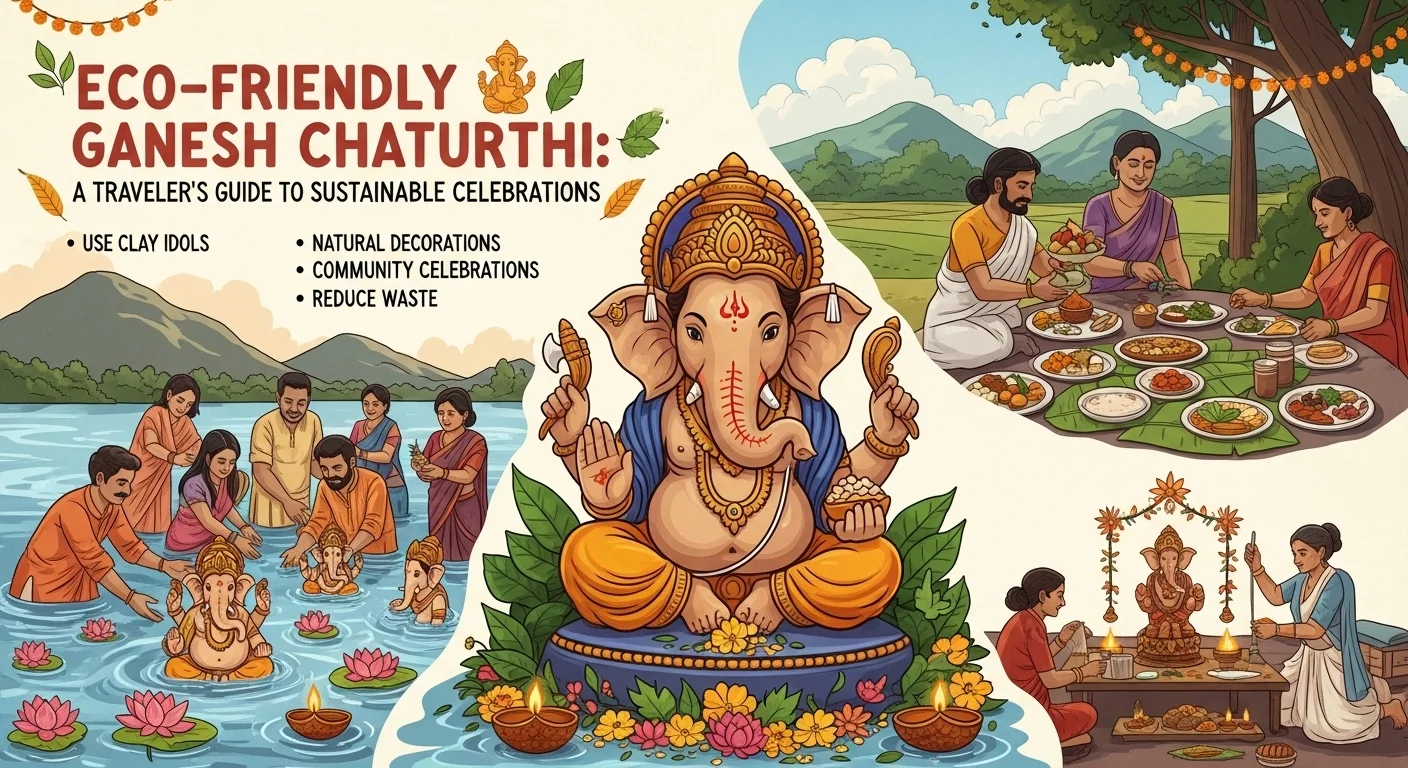Ganesh Chaturthi is one of India’s most beloved festivals, a time of pure joy, vibrant colors, and infectious energy. For ten days, homes and streets come alive with music, devotion, and beautifully crafted idols of Lord Ganesha. But in recent years, a new, important trend has emerged: the move towards a more conscious and sustainable celebration. The rise of Eco-Friendly Ganesh Chaturthi shows that we can honor our traditions and protect our planet at the same time.
For travelers, this is an incredible opportunity to experience a cultural shift firsthand, where spirituality and sustainability go hand in hand.
Why Eco Friendly Ganesh Chaturthi Matters
Traditionally, Ganesh festival idols were made of natural clay. However, over time, plaster of Paris idols became popular due to their durability and low cost. The problem? They don’t dissolve easily and are painted with toxic chemicals that pollute our rivers and lakes during the visarjan, or immersion, ceremony.
That’s why Eco-Friendly Ganesh Chaturthi is so important. These green celebrations use idols made from clay, natural soil, or even seeds, which are decorated with organic paints. Instead of polluting a natural water body, these idols are immersed in artificial tanks or even garden pots, where they simply return to the earth. For a traveler, it’s a way to witness devotion that truly respects nature.
Must Read: Ganesh Chaturthi 2025: Date & Puja Timings, Shubh Muhurat, Vinayak Chaturthi Tithi, Vidhi and More
Top Destinations for a Sustainable Ganesh Festival
Here’s a guide to some of the best cities to experience Eco-Friendly Ganesh Chaturthi.
1. Mumbai, Maharashtra
- Mumbai is the undisputed heart of the Ganesh festival. While it’s famous for massive idols like Lalbaugcha Raja, many community mandals have embraced a sustainable path. They now use clay idols, decorate with reusable paper instead of plastic, and conduct immersions in designated artificial ponds to protect the Arabian Sea. As a visitor, you can feel the energy of the big pandals while also discovering the heartwarming sustainability efforts of smaller, local celebrations.
Must Read: Anant Chaturdashi 2025: Your Guide to Mumbai’s Grand Ganesh Visarjan
2. Pune, Maharashtra
- Pune’s festival is known for its cultural programs and community spirit. Here, artisans are crafting stunning eco-friendly Ganesh idols using clay, coconut husks, and natural dyes. For travelers, many local groups offer workshops where you can learn to create your own eco-friendly Ganesh idol—a truly unique, hands-on experience of a green celebration.
3. Bangalore, Karnataka
- Bangalore is a true pioneer of Eco-Friendly Ganesh Chaturthi. The city has made huge strides in promoting sustainable celebrations by setting up hundreds of artificial immersion tanks. The emphasis here is on responsible practices, from discouraging plastic decorations to organizing markets where you can buy eco-friendly festival goods. You can join in the vibrant processions knowing that the environmental impact is being minimized.
4. Hyderabad, Telangana
- Hyderabad offers a fantastic blend of tradition and innovation. Some artisans are creating Ganesh idols from clay mixed with plant seeds. When immersed, the idol dissolves, and the seeds left behind can sprout, symbolizing new life and rejuvenation. For a traveler, it’s a beautiful way to see how religion and environmental awareness can merge. This is a unique approach to Eco-Friendly Ganesh Chaturthi.
5. Goa
- In Goa, Ganesh Chaturthi (or Chavath) is primarily a family affair. Unlike the massive city-wide pandals, most families bring home small clay idols and perform the immersion in their own backyard ponds or wells. If you want to experience the festival in its purest, most personal, and naturally sustainable form, Goa is the perfect destination.
Must Read: Why Must-Visit Shri Siddhivinayak Temple: Timings, Rituals & Darshan Tips for Ganesh Chaturthi and All You Should Know About

How Travelers Can Participate in Eco Friendly Ganesh Chaturthi
- Visit environmentally friendly pandals that employ clay idols and eco-friendly decorations.
- Support local craftsmen creating natural idols rather than factory-produced POP ones.
- Opt for smaller community gatherings rather than huge processions to avoid over-crowding and wastage.
- Bring reusable bottles, bags, and essentials to prevent adding to plastic wastage.
- Follow immersion rules by going in for artificial tanks if you plan to take part.
Best Time to Visit
Ganesh Chaturthi starts on August 27 in 2025 and concludes on September 6 with Anant Chaturdashi. For a complete experience of the Eco Friendly Ganesh Chaturthi festival, tourists must reach at least a couple of days in advance to enjoy the preparation, idol installations, as well as cultural performances.
A Meaningful Travel Experience
Attending Eco Friendly Ganesh Chaturthi is not just about watching rituals, it’s about being part of a cultural shift. You’ll hear the rhythmic beats of drums, witness mesmerizing dances, taste festive sweets like modaks, and join processions filled with joy. But at the same time, you’ll see clay idols dissolving harmlessly, artificial ponds saving water bodies, and communities uniting for a cleaner planet.
Conclusion
Ganesh Chaturthi was always a festival of devotion, harmony, and faith. With the increasing consciousness toward green practices, it now also represents responsibility towards nature. For tourists, celebrating Eco Friendly Ganesh Chaturthi is experiencing the same majesty of devotion while showing support towards sustainable decisions. From Mumbai to Pune, Bangalore to Hyderabad, and Goa, these festivities provide a blend of culture, tradition, and nature consciousness making it really a remarkable and memorable travel experience.







